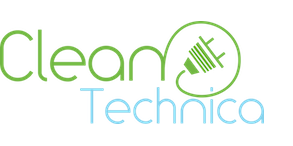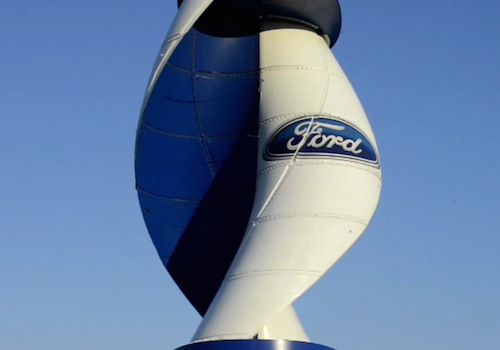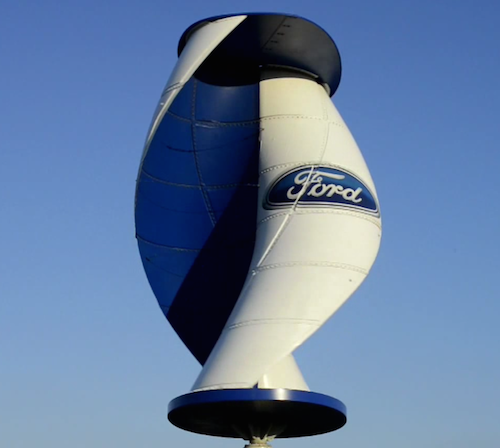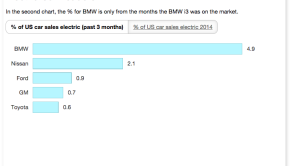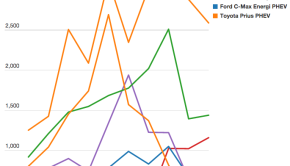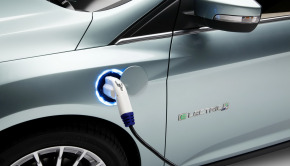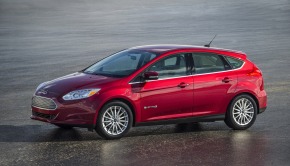Micro Wind Turbines Could Be Huge Deal For Ford
November 13th, 2014 by Tina Casey
Ford has just tapped four dealerships to receive micro wind turbines in a first-of-its-kind partnership with the aptly named company Wind Energy Corporation, and we are already convinced this is just the first tiny ripple in a massive wave of wind energy installations at Ford locations. The new vertical-design turbines spell out Ford in big, bold letters, providing a perfect example of the unique branding and marketing opportunities that micro wind turbines provide to businesses.
The idea is, if you’re going to spend money on an elevated sign anyways, you might as well put it into service generating clean, renewable energy to attract and serve your growing cadre of energy-aware customers and EV buyers.
The Wind Energy Corporation Micro Wind Turbine
Ford’s press material on the new micro wind turbines was a little thin on detail and the website for Wind Energy was under construction at the time of this writing, but the folks at Wind Energy were nice enough to email additional specs for the wind turbine.
The vertical wind sail micro wind turbine is part of a proprietary integrated system that includes a 5.5 kilowatt wind energy generator and a 7.0 kilowatt solar panel array (available as rooftop or ground mounted), all coordinated with smart electrical and control systems. Wind Energy calls it, what else, The Windy System™.
According to Ford, each Windy System can deliver about 20,000 kilowatt-hours of electricity annually, which is enough to charge a Ford Focus Electric 870 times.
The turbine is designed specifically for placement in proximity to buildings and people, meaning that it is quiet, and Wind Energy claims that it is “bird-bat-butterfly friendly.” At about 20 feet tall and 13 feet in diameter, the slim silhouette also helps from an aesthetic point of view. Overall, the turbine plus the tower is 50 to 65 feet tall.
As for durability, anything at 6 mph and more gets you a current, although the turbine will lock down for safety if things reach a hectic 40 mph.
Micro Wind Turbines And Ford
Along with our sister site Gas2.org we’ve been following Ford’s transition into the EV market. Aside from retail hybrid and electric vehicles, the company has also been all over sustainable strategies at its manufacturing sites, and it has become one of the leaders in the trend toward renewable energy packaging for home EV charging.
Extending the renewable energy messaging out to the company’s dealers was the next step. Under the terms of the new partnership, Wind Energy will put up $750,000 to install The Windy System at the four dealerships (we didn’t ask, but that sounds like a power purchase agreement to us). Aside from EV charging, the output will also go to power outdoor lighting and indoor energy use.
Apparently Ford and Wind Energy tapped the four dealers in recognition of their “exceptional commitment to clean energy” as well as their suitability as wind and solar energy sites, so let’s give them a shout-out:
Dana Ford Lincoln, Staten Island, New York
Tom Holzer Ford, Farmington Hills, Michigan
The Ford Store, Morgan Hill, California
Fiesta Ford, Indio, California
Advantages Of Micro Wind Turbines
While we’ve been huge fans of tall-tower, utility scale wind turbines (especially in the emerging offshore wind energy sector), we also have the loves for micro wind turbines. You don’t get the scale efficiencies, but with micro wind turbines commercial property owners and tenants do get the twofer of doubling up signage with renewable energy generation. If your wind is in the doldrums, no problem, because the turbine still functions as a sign.
It’s also worth noting that, despite some naysayers in the wind industry, the US Department of Energy is anticipating that micro wind turbines will play a role in the future energy landscape.
Wind Energy’s choice of turbine dovetails with the branding aspect because unlike bladed turbines, the wind sail’s broad, sail-like surfaces lend themselves to lettering and other graphics.
Speaking of branding, the folks at Ford were nice enough to invite us along last spring when they introduced the new tricked-out 2015 Edge, and they included a brief overview of the Ford licensing program for retail in the package. Have you checked out the Ford merch store lately? We’re thinking that aside from dealerships, some of those Ford fans out there will want to get their hands around a Ford-branded micro wind turbine.
For that matter, given the growing popularity of micro wind turbines at sports venues, team-branded micro wind turbines for sporting goods stores could be next on the horizon.
Keep up to date with all the hottest cleantech news by subscribing to our (free) cleantech newsletter, or keep an eye on sector-specific news by getting our (also free) solar energy newsletter, electric vehicle newsletter, or wind energy newsletter.
-
Joseph Dubeau
-
andereandre
-
spec9
-
Jenny Sommer
-
-
ADW
-
Adrian
-
ADW
-
-
Kevin McKinney
-
-
Hans
-
MarTams
-
harisA
-

